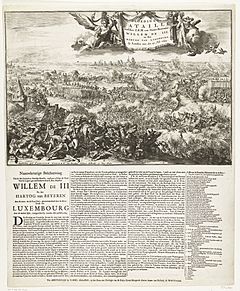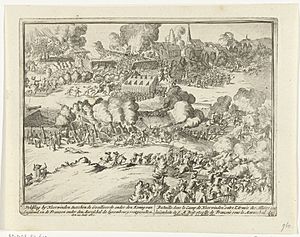Battle of Landen facts for kids
Quick facts for kids Battle of Landen |
|||||||
|---|---|---|---|---|---|---|---|
| Part of the Nine Years' War | |||||||
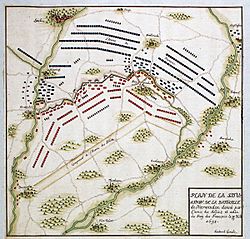 Map of the battle. The Allied armies are in red. |
|||||||
|
|||||||
| Belligerents | |||||||
| Commanders and leaders | |||||||
| Strength | |||||||
| 66,000-70,000 70 guns |
50,000-60,000 80-100 guns |
||||||
| Casualties and losses | |||||||
| 8,000 to 10,000 killed or wounded 15,000 killed or wounded |
9,500 killed, wounded or captured, plus 80 guns 12,000 to 14,000 killed, wounded or captured plus 60 guns 16,500 killed, wounded or captured, plus 84 guns 18,000 to 20,000 killed, wounded or captured, plus 80 guns |
||||||
The Battle of Landen, also known as Neerwinden, took place on 29 July 1693, during the Nine Years' War near Landen in modern Belgium. A French army under Marshal Luxembourg defeated an Allied force led by William III.
By 1693, all combatants were struggling with the financial and material costs of the conflict. Hoping to end the war with a favourable negotiated peace, Louis XIV of France decided first to improve his position by taking the offensive. Luxembourg, French commander in the Spanish Netherlands saw a chance to engage William near Landen. The allies were in a strong but extremely dangerous position, with a river to their rear.
Most of the fighting took place on the Allied right, around the only bridge over the river, which was strongly fortified and defended by the bulk of their artillery. The French assaulted the position three times before finally breaking through the defences; the Allies were forced to retreat and abandon their guns.
Although a clear French victory, as with the Battle of Steenkerque the previous year, both sides suffered heavy casualties and Louis failed to achieve the decisive result that would force the Allies to negotiate peace. William quickly replaced his losses and by 1694 had achieved numerical superiority in Flanders for the first time in the war.
Background
Since the outbreak of the Nine Years' War, the French had generally had the better of operations in the Spanish Netherlands, capturing Namur and repelling an Allied surprise attack at Steenkerque in 1692. However, they had failed to achieve a decisive victory or split up the Grand Alliance, while attempts to restore James II had been ended by the Treaty of Limerick in 1691, followed by an Anglo-Dutch naval victory at La Hogue in 1692. For the first time, the strategic situation seemed to be moving in favour of the Allies.
However, by now all sides were struggling with economic downturns and famine caused by the Little Ice Age, a prolonged period of colder weather exacerbated by war. After four poor years, the 1693 harvest failed completely throughout Europe, causing catastrophic famine; between 1695 and 1697, an estimated two million died of starvation in Southern France and Northern Italy alone. Conducting military campaigns in these circumstances was made problematic by an increase in the average size of armies from 25,000 in 1648 to over 100,000 by 1697. Such levels were unsustainable for pre-industrial economies and they fell back to around 35,000 in the subsequent 1701 to 1704 War of the Spanish Succession.
These factors particularly affected France, which was also fighting a multi-front war on its own and needed peace, but Louis XIV of France always sought to improve his position before negotiating. In doing so, he held two key advantages over his opponents, an undivided command and vastly superior logistics. This allowed the French to mount offensives at least month earlier than the Allies, quickly seize their objectives and then assume a defensive posture. In 1693, Louis took the offensive in the Rhineland, Flanders and Catalonia. When the attack in Germany proved unexpectedly successful, in early June Luxembourg was ordered to reinforce it with 28,000 of his own troops and prevent the Allies doing the same. Louis also ordered Luxembourg to capture Liège, the capital of the Prince-Bishopric of Liège.
Prelude
Luxembourg increased his field force to 116,000 by stripping garrisons from towns throughout Maritime Flanders, including Dunkirk and Ypres. On 9 June, he embarked on a series of marches, simultaneously threatening Liège, Huy and Charleroi; the Governor of the Spanish Netherlands, Maximilian of Bavaria, insisted on covering all three, forcing the Allies to divide their army.
However, the number of troops available to Luxembourg was not enough to lay siege to Liège while also keeping the Allied main force at bay. William III took advantage of the impasse in French strategy to send Lieutenant-General Ferdinand Willem of Wurttemberg with a corps of 15,000-16,000 men to the northern French province of Artois. He had orders to collect contributions and, if the inhabitants refused to pay, to reduce their houses and farms to ashes. Wurttemburg engaged the French, under La Vallette, on 18 July and broke through the lines of the Scheldt near Dottignies. The inhabitants of Artois ended up paying contributions amounting to 6 million guilders.
On 18 July, Luxembourg ordered Villeroy to move against the small fortress town of Huy; the Allies marched to its relief, but before they could do so, the town surrendered on 23 July. William now halted and reinforced Liège with an additional ten battalions, bringing the garrison to 17,000. His remaining troops established a line running in a rough semicircle from Eliksem on the right, to Neerwinden on the left; although this provided flexibility of response, movement was restricted by the Little Geete River, three kilometres to the rear.
Seeing an opportunity, on 28 July Luxembourg reversed his route, and after a forced march of 30 kilometres, arrived at the village of Landen in the early evening. Luxembourg assumed that William would retreat and wait for the return of Würtemberg's corps before risking a battle. William was notified of the French approach by mid-afternoon, but despite being advised to slip across the river at night, he decided to stand and fight and to let Würtemberg complete his mission. His main reason appears to have been that his shortage of mounted troops made an orderly retreat problematic, while the ground selected presented a good opportunity to inflict heavy casualties on the French cavalry. Although he was outnumbered by 66,000 to 50,000 and the area enclosed by his troops was too restricted to allow them to manoeuvre freely, the small battlefield would also prevent Luxembourg from making full use of his superior numbers.
The Allied right was key to the position, as it protected their only line of retreat across the Geete. They constructed strong defences, anchored by the villages of Laar and Neerwinden; 80 of their 91 pieces of heavy artillery were placed behind them. In the centre, the open ground between Neerwinden and Neerlanden was solidly entrenched with the village of Rumsdorp as an advance post. The left, which rested on Landen brook and was the hardest to attack, saw little action until the end of the battle.
The Allied right wing was placed under the command of Maximilian of Bavaria. Spanish dragoons and Hanoverian infantry were placed on the far right in the town of Laar, the English Brigade of Ramsey in between Laer and Neerwinden and troops from Brandenburg inside Neerwinden. Behind them, William positioned 47 squadrons of cavalry in two lines, largely from Hanover, Brandenburg, Bavaria and Spain. The centre was led by William himself and was primarily held by English and Scottish troops. The Danish auxiliaries and the Dutch positioned themselves under the Frisian Stadtholder Henry Casimir II in and around Neerlanden on the left flank, with 59 squadrons of Anglo-Dutch cavalry under the Prince of Nassau-Usingen directly behind them. Four infantry battalions were designated for the occupation of Rumsdorp.
Luxembourg concentrated his main assault force of 28,000 men against the Allied right, while his subordinates carried out secondary attacks on their left and centre, to prevent it being reinforced. These would be carried out by three lines of cavalry, supported by two lines of infantry and a further three lines of cavalry behind while a strong force of infantry and dragoons attacked Rumsdorp.
Battle
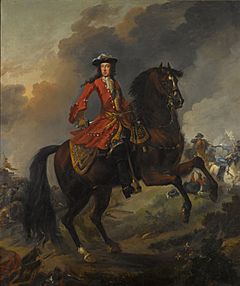
The artillery duel probably started between 6:00 and 7:00. The army of the Dutch Republic always possessed very large amounts of artillery and the Allied artillery regiments were better equipped than those of the French. The duel thus went largely in favour of the Allies and they inflicted terrible destruction on the French. With about 150 artillery pieces in total, it was very intense. In a letter to the Prince of Condé the Prince de Conti wrote:
... the most valiant officers of our army had never seen such a cannonade, so long and so close, and more like the fighting at sea than on land.
Somwhere between 8 and 9 a.m. the French began their attack on Laar and Neerwinden. Three assault columns, consisting of 28 battalions, launched a furious attack; the Duke of Berwick in the middle stormed Neerwinden, while to his left the Lieutenant-General Rubantel and to his right the Lieutenant-General De Montchevreuil, supported his attack. Laer was soon captured, but things went less well for the French in Neerwinden. Here the French had to take every part of the village separately and the defenders fought with great bravery. Berwick managed to gain ground only slowly. While this was going on, French cavalry, after conquering Laer, pushed across the Laerderbeek and attacked the Spanish cavalry, which it overran. But the French were in turn thrown back across the stream with great losses. This attack, however, caused the gunners of English battery on the heights behind Laar to evacuate their position without receiving orders to do so.
Berwick penetrated through to the edge of Neerwinden, but Rubantel and Montchevreuil, were unable to keep advancing on beside him, and, in the face of the great fire directed by the defender at their flanks, deviated more and more towards the centre of the village and finally retreated behind Berwick. This would become fatal to them. A counterattack by the Elector of Bavaria on the flanks of Rubantel and Montchevreuil forced them both out of the village and then Berwick's corps, after which Laar was also recaptured. This important counterattack, carried out with the help of English battalions from the centre sent by William III, restored the original allied lines. The French had suffered very heavy losses, Montchevreuil had been killed and Berwick captured.
About the same time as this attack on Neerwinden or a little later, the French also attacked Rumsdorp and Neerlanden. Rumsdorp was taken by them, but their attack on the entrenched line behind it was repulsed. East of the Molenbeek, dismounted dragoons stormed Neerlanden, penetrated it twice, but were thrown back each time. Here the fight took on a ferocity that was not at all in Luxemburg's intention. Both he and William rushed to this wing. Luxembourg expressed his displeasure and ordered that they should fall back and stick to holding the outer fence of Rumsdorp. He then returned to his left wing, where the battered troops of the assault on Neerwinden were gathered. He reorganised and reinforced this wing with 12 battalions from his general reserve and ordered a second attack on Laar and Neerwinden, this time led by the Prince de Conti.
This second attack took much the same course as the first. Again, Laer was taken first; in Neerwinden the defender fought behind hedges and walls and from the houses with great courage and perseverance, without however being able to prevent de Conti from slowly penetrating to the northern edge of the village. Here, however, the defenders again held their ground through great effort. Again William III rushed in with English battalions to the action, and counterattacked. With the exception of the south-western edge, Neerwinden was recaptured after a long and bloody battle and then Laar too. The stubbornness with which 44 French and probably 33 German and English battalions, 30,000 to 40,000 men in all, fought here in a confined space and a short distance caused very heavy losses on both sides.
Midday was approaching and Luxembourg was still far from accomplishing his intended goal. His subordinates advised him, in view of the sinking courage of his troops and the great losses his infantry had suffered, to break off the fight. But Luxembourg decided otherwise. He still had 20 battalions of infantry in reserve, including seven battalions of the Maison du Roi, the elite of the French army, and his cavalry of 30,000 men was still almost intact.
Luxembourg took 7,000 infantry from his centre and left wing for a third attack on the allied right. He ordered an attack with the entire infantry at once, while personally leading the attack on Laar and Neerwinden. William again moved additional English units to meet this threat, but this could not prevent the villages from finally both falling into French hands after very heavy fighting. They were helped in this by the depletion of the defenders' ammunition. Subsequently, de Feuquières ordered his cavalry to charge the weakened Allied centre; among them was the Irish Brigade, who suffered severe losses, including the Irish Jacobite hero Patrick Sarsfield, but the French over-ran the Allied entrenchments, inflicting heavy casualties.
This French breakthrough happened around 15:00 and an hour later William ordered the Allies to retreat over the Geete. Doing so they abandoned most of their artillery which was entrenched and could not be withdrawn in time. There were by now 125 squadrons behind the allied lines and the battle had dissolved into a hand-to-hand combat of 30,000 to 40,000 horsemen clashing in a space of less than three square kilometres. William led a number of cavalry charges himself and this allowed the right flank to retreat across te Geete. They did this in disarray, but William and Maximilian managed to get to safety with a number of the troops.
The Dano-Dutch left wing under Hendrik Casimir fared better in their retreat, despite the strong resistance they faced. During their retreat his troops faced not only the enemy infantry in Rumsdorp and Attenhoven, but also the majority of the 125 French squadrons under Feuquières, which surrounded them from all sides. They however managed to fight their way through the French over a distance of about 7 kilometres and crossed the Geete in good order. Another Nine battalions of Dutch and Danish infantry under Count Solms and brigadier François Nicolas Fagel also fought a stubborn rearguard action, supported by several British units holding positions around the bridge. Solms was mortally wounded and a few hundred allied horsemen had drowned trying to cross the Geete, but by 17:00 most of the army had reached the other side of the river and continued their retreat, undisturbed by the French cavalry.
Aftermath
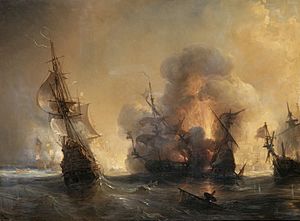
Whereas usually French generals announced their victories with much detail and praise, this time Luxembourg sent only a summary message to the king. Landen might have been a crushing victory if the simultaneous attacks he ordered on the Allied left and centre had gone as planned. As it was, both sides suffered heavy casualties. However, estimated casualties varied widely. The French themselves claimed to have lost between 7,000 and 8,000 men. This was disputed by the editor of a Dutch newspaper who alerted readers to the fact that it was "a regular habit" for the French to manipulate casualty figures, but that they had really overdone it this time. French officer De la Colonie also came to a different conclusion and wrote that they had lost 18,000 to 20,000 men:
Their loss was reckoned to be at least fourteen or fifteen thousand men and twenty-eight pieces of cannon. Our own loss was so considerable that it was never exactly shown in the returns. The glory of victory was ours, but we paid dearly for it. We lost eighteen to twenty thousand men, including a great number of officers of distinction [...] The enemy called this action the Battle of the Fascines, on account of those that our men carried and the immense number of our killed, who, as they declared, were used as fascines to fill in the ditches.
Estimates of Allied losses range from 8,000 to 18,000 killed and wounded, with another 1,500 or 2,000 captured, mostly Dutch troops cut off in Rumsdorp, which they held for most of the day. A visitor to the area in 1707 noted the fields were still scattered with the bones of the dead.
William had a silver medal struck to celebrate his success in 'saving Liege' and escaping with the bulk of his troops. This was partly propaganda to counter the Battle of Lagos on 27 June, when the French intercepted a large Anglo-Dutch convoy and inflicted serious commercial damage, but there was also truth to the claim. Luxembourg's infantry was so battered that he indeed had to refrain from besieging Liège, while the Dutch were able to replace their losses within days. A mutiny even broke out in the French army in which entire regiments rioted and demanded payment of back pay in threatening fashion. Louis XIV sent money and ordered Luxembourg to return to the French border to reassure the troops that they did not have to fight another battle. For these reasons the battle has also been described as a Pyrrhic victory.
The fact that William was able to save Liège and Maastricht from an attack, and the success of the Duke of Württemburg’s raid in French Flanders meant that the 1693 campaign could be seen as overall Allied success. Still, the loss of Namur in 1692 followed by the defeat at Landen was evidence to William and Anthonie Heinsius, the Dutch Grand Pensionary, that the numerical inferiority of the Allies made it difficult to effectively protect the Spanish Netherlands. As a result, the Anglo-Dutch armies grew significantly in the following years, allowing William and the Allied army to go on the offensive for the next three years.
Although Luxembourg has been criticised for failing to exploit his victory, his troops were exhausted, while the poor harvests of previous years meant a lack of forage for the horses and baggage train needed to pursue his opponents. The problem was so acute that capturing the Allied artillery proved a mixed blessing, as the French scarcely had sufficient to move their own. The offensive came to an end, although Charleroi was captured in October. Landen would be Luxembourg's last battle as he died in January 1695, depriving Louis of his best general.
Legacy
Laurence Sterne's famous 1759 picaresque novel Tristram Shandy contains various references to the Nine Years' War, mostly the 1695 Second Siege of Namur. However, Corporal Trim refers to the Battle of Landen as follows:
Your honour remembers with concern, said the corporal, the total rout and confusion of our camp and army at the affair of Landen; every one was left to shift for himself; and if it had not been for the regiments of Wyndham, Lumley, and Galway, which covered the retreat over the bridge Neerspeeken, the king himself could scarce have gained it – he was press'd hard, as your honour knows, on every side of him...
It is during this battle that, seeing the French determination to gain the high ground in spite of the murderous Allied bombardment, William is alleged to have exclaimed "Oh! That insolent nation!".
Sources
See also
 In Spanish: Batalla de Landen para niños
In Spanish: Batalla de Landen para niños


